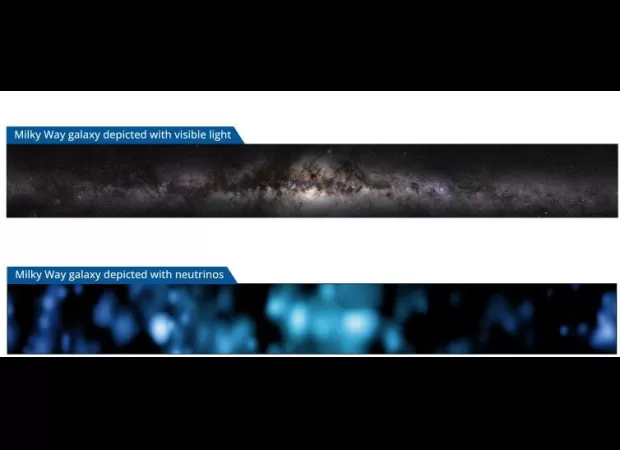Gorgeous photo of the Milky Way seen through a massive ice cube.
Our galaxy, the Milky Way, looks like its reflection in a giant ice cube made of ghost particles.

The Milky Way is a majestic sight when viewed from Earth; it can even be seen with the naked eye when free from light pollution. And now, thanks to the IceCube Neutrino Observatory, an incredible image of our galaxy has been captured, using the reflection of ghost particles.
Located deep in the Antarctic, IceCube is home to over 5,000 detectors set within a square kilometre of ice. This ice is so clear that it is ideal for spotting neutrinos, which are some of the smallest particles in the universe. Neutrinos are everywhere and pass through us undetected, as they rarely interact with other particles or waves.
However, when neutrinos collide with an atom nucleus, they leave behind a blue cone of light that can be detected by IceCube. Over the past decade, hundreds of scientists have analysed over 60,000 of these collisions and used machine learning to trace them back to their origins. This has allowed them to create a stunning image of the Milky Way.
“As is so often the case, significant breakthroughs in science are enabled by advances in technology,” said Denise Caldwell, director of US National Science Foundation’s Physics Division. “The capabilities provided by the highly sensitive IceCube detector, coupled with new data analysis tools, have given us an entirely new view of our galaxy – one that had only been hinted at before.”
The image of the Milky Way is a beautiful sight; it includes the usual glittering stars, shining dust and dark clouds, which are shown as ghostly blue and white pebbles against the inky blackness of space.
So where do these neutrinos come from? According to Nasa, they are mostly generated by extreme events in space like violent galactic outbursts. On Earth, they are also produced by people and power stations.
“The strong evidence for the Milky Way as a source of high-energy neutrinos has survived rigorous tests by the collaboration,” said Ignacio Taboada, a professor of physics at the Georgia Institute of Technology and IceCube spokesperson. “Now the next step is to identify specific sources within the galaxy.”
Naoko Kurahashi Neilson, professor of physics at Drexel University and an IceCube member added: “Observing our own galaxy for the first time using particles instead of light is a huge step. As neutrino astronomy evolves, we will get a new lens with which to observe the universe.”
The study has been published in the journal Science, and gives humanity a new window into the secrets of the universe. Who knows what further secrets may be revealed as neutrino astronomy continues to evolve?






